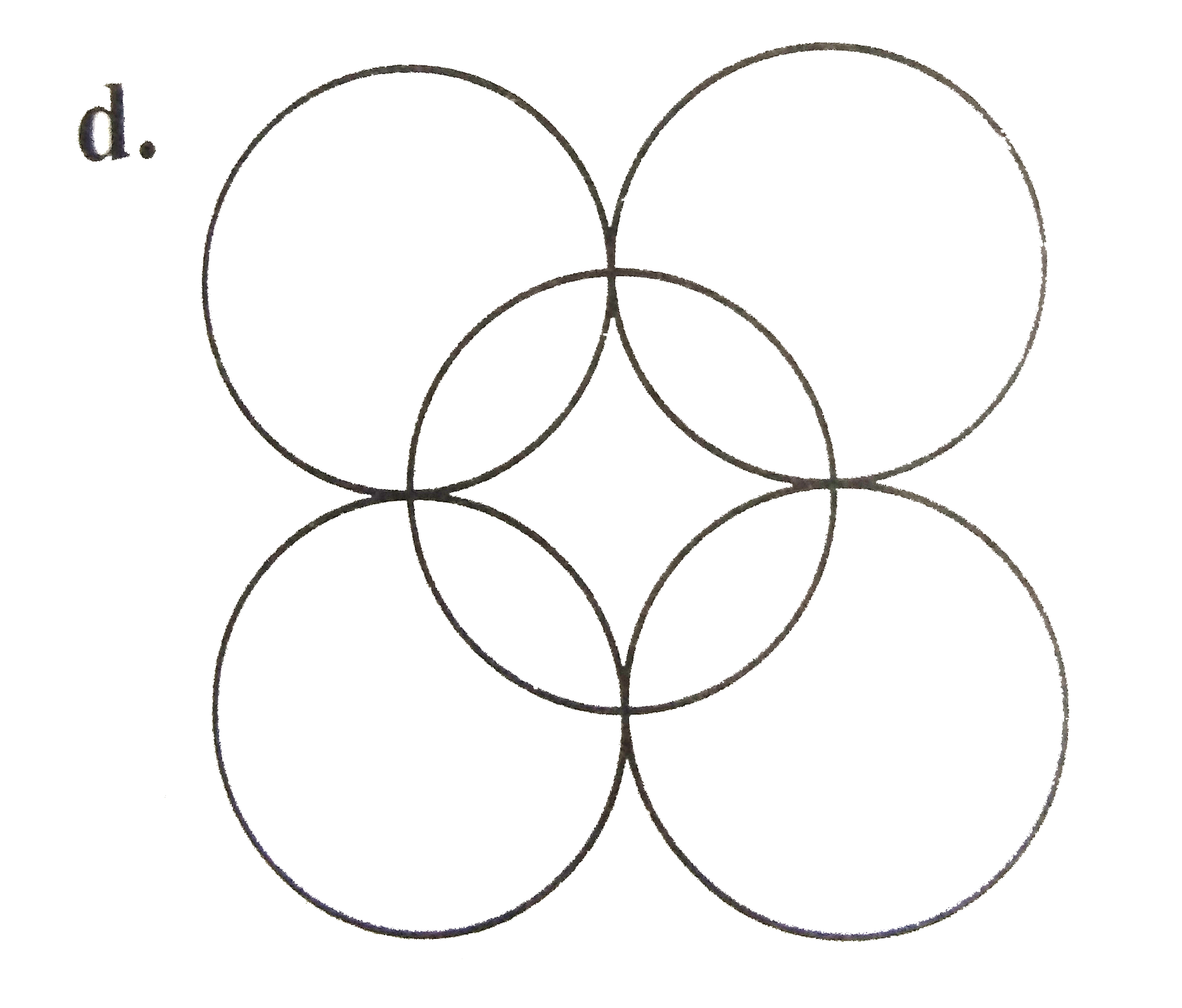AX,AY,BX, and BY have rock salt type structure with following internuclear distances:
∣∣
∣
∣
∣
∣
∣
∣∣SaltAnion-anionCation-aniondistance inÅdistance inÅAX2.401.70AY1.631.15BX2.661.88By2.091.48∣∣
∣
∣
∣
∣
∣
∣∣
Ionic radii of A⊕ and B⊕, respectively, are
a.0.35 and 0.68Å
b.0.68 and 0.35Å
c.1.20 and 0.80Å
d.0.80 and 1.20Å
0.35 and 0.68Å
0.68 and 0.35Å
1.20 and 0.80Å
0.80 and 1.20Å
The correct Answer is:A
To determine the ionic radii of A+ and B+ cations in the rock salt type structure, we will use the given inter-nuclear distances of the anions and cations. The distances provided are:
- For AX:
- Anion-anion distance (X-X) = 2.40 Å
- Cation-anion distance (A-X) = 1.70 Å
- For AY:
- Anion-anion distance (Y-Y) = 1.63 Å
- Cation-anion distance (A-Y) = 1.15 Å
- For BX:
- Anion-anion distance (X-X) = 2.66 Å
- Cation-anion distance (B-X) = 1.88 Å
- For BY:
- Anion-anion distance (Y-Y) = 2.09 Å
- Cation-anion distance (B-Y) = 1.48 Å
Step 1: Calculate the radius of the anion R−
Using the anion-anion distance for AX:
RX−=Anion-Anion Distance (X-X)2=2.40Å2=1.20Å
Step 2: Calculate the radius of cation B+
Using the cation-anion distance for BX:
RB+=Cation-Anion Distance (B-X)−RX−=1.88Å−1.20Å=0.68Å
Step 3: Calculate the radius of cation A+
Using the cation-anion distance for AY:
RA+=Cation-Anion Distance (A-Y)−RY−
First, we need to find RY− using the anion-anion distance for AY:
RY−=Anion-Anion Distance (Y-Y)2=1.63Å2=0.815Å
Now substituting this back:
RA+=1.15Å−0.815Å=0.335Å≈0.35Å
Final Result
The ionic radii of A+ and B+ are:
- RA+=0.35Å
- RB+=0.68Å
Thus, the correct option is a. 0.35 and 0.68Å.
---
- Anion-anion distance (X-X) = 2.40 Å
- Cation-anion distance (A-X) = 1.70 Å
- Anion-anion distance (Y-Y) = 1.63 Å
- Cation-anion distance (A-Y) = 1.15 Å
- Anion-anion distance (X-X) = 2.66 Å
- Cation-anion distance (B-X) = 1.88 Å
- Anion-anion distance (Y-Y) = 2.09 Å
- Cation-anion distance (B-Y) = 1.48 Å
RX−=Anion-Anion Distance (X-X)2=2.40Å2=1.20Å
RB+=Cation-Anion Distance (B-X)−RX−=1.88Å−1.20Å=0.68Å
RA+=Cation-Anion Distance (A-Y)−RY−
First, we need to find RY− using the anion-anion distance for AY:
RY−=Anion-Anion Distance (Y-Y)2=1.63Å2=0.815Å
Now substituting this back:
RA+=1.15Å−0.815Å=0.335Å≈0.35Å
- RA+=0.35Å
- RB+=0.68Å
Topper's Solved these Questions
- SOLID STATEBOOK - CENGAGE CHEMISTRY ENGLISHCHAPTER - SOLID STATEEXERCISE - Exercises (Multiple Correct)
39 Videos
- SOLID STATEBOOK - CENGAGE CHEMISTRY ENGLISHCHAPTER - SOLID STATEEXERCISE - Exercises (Single Correct)
72 Videos
- SOLID STATEBOOK - CENGAGE CHEMISTRY ENGLISHCHAPTER - SOLID STATEEXERCISE - Solved Examples
13 Videos
- REDUCTION AND OXIDATION REACTION OF ORGANIC COMPOUNDSBOOK - CENGAGE CHEMISTRY ENGLISHCHAPTER - REDUCTION AND OXIDATION REACTION OF ORGANIC COMPOUNDSEXERCISE - SUBJECTIVE TYPE
4 Videos
- SOLUTIONSBOOK - CENGAGE CHEMISTRY ENGLISHCHAPTER - SOLUTIONSEXERCISE - Ex 2.3 (Objective)
9 Videos
Similar Questions
AX,AY,BX, and BY have rock salt type structure with following internuclear distances:
∣∣ ∣ ∣ ∣ ∣ ∣ ∣∣SaltAnion-anionCation-aniondistance inÅdistance inÅAX2.401.70AY1.631.15BX2.661.88By2.091.48∣∣ ∣ ∣ ∣ ∣ ∣ ∣∣
Ionic radii of X⊕ and YΘ, respectively, are
View SolutionAX,AY,BX, and BY have rock salt type structure with following internuclear distances:
∣∣ ∣ ∣ ∣ ∣ ∣ ∣∣SaltAnion-anionCation-aniondistance inÅdistance inÅAX2.401.70AY1.631.15BX2.661.88By2.091.48∣∣ ∣ ∣ ∣ ∣ ∣ ∣∣
Which of the following structure is, respectively, by Ax?
(a)
(b)
(c)
(d)
View SolutionAX,AY,BX, and BY have rock salt type structure with following internuclear distances:
∣∣ ∣ ∣ ∣ ∣ ∣ ∣∣SaltAnion-anionCation-aniondistance inÅdistance inÅAX2.401.70AY1.631.15BX2.661.88By2.091.48∣∣ ∣ ∣ ∣ ∣ ∣ ∣∣
The structure given below is of

(a)AX
(b)AY,BX
(c)AY,BX,BY
(d)AY,BX,BYandKCI
View SolutionAX,AY,BX, and BY have rock salt type structure with following internuclear distances:
∣∣ ∣ ∣ ∣ ∣ ∣ ∣∣SaltAnion-anionCation-aniondistance inÅdistance inÅAX2.401.70AY1.631.15BX2.661.88By2.091.48∣∣ ∣ ∣ ∣ ∣ ∣ ∣∣
A salt MY crystallizes in the CsCl structure. The anions at the corners touch each other and cation is in the centre. The radius ratio (r⊕/rΘ) for this structure is
View SolutionSuggest the probable structures of the unit cells of the following each compound with the help of given data
∣∣ ∣ ∣ ∣ ∣ ∣∣Cationic radiusAnionic radius(a)RbBe1.04Å1.95Å(b)MeTe0.65Å2.21Å(c)MgO0.65Å1.40Å(d)BaO1.35Å1.40Å∣∣ ∣ ∣ ∣ ∣ ∣∣
View SolutionThe ionic radii of Rb+ and I− are 1.46 and 2.16Å. The most probable type of structure exhibited by it is:
View SolutionThe uncertainty involved in the measurement of velocity of electron with in a distance of 0.1Å is :
View SolutionSalt AB has a zinc blend structure. The radius of A2+ and B2− ion are 0.7Åand1.8Å respectively. The edge length of AB unit cell is:
View SolutionA diatomic molecule has dipole moment of 1.2D. If the bond distance is 1Å what parcentage of covalent in the molecule is
View SolutionIn cubic ZnS(II−VI) compounds, if the radii of Zn and S atoms are 0.74Å and 1.70Å, the lattice parameter of cubic ZnS is
View Solution
